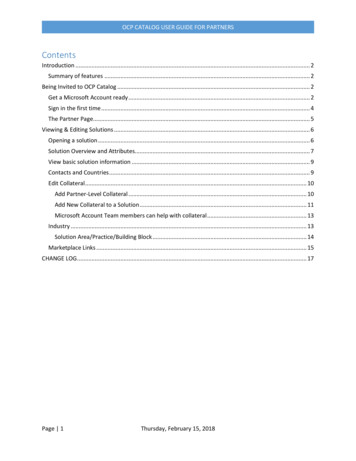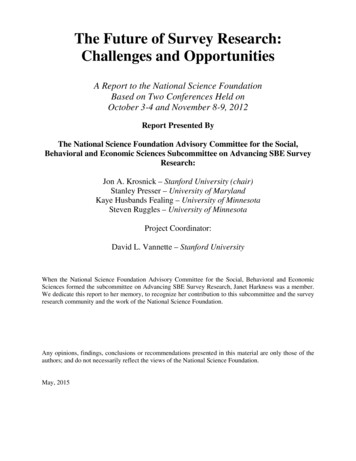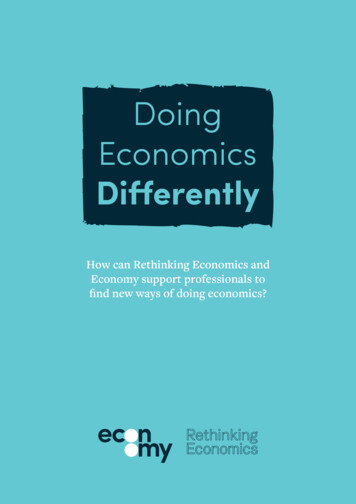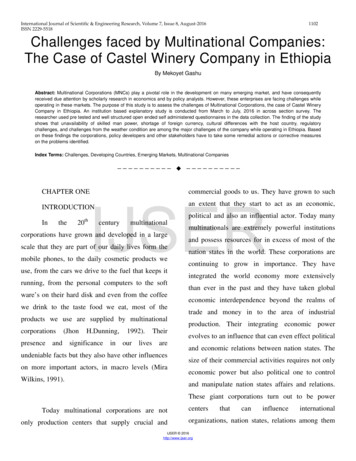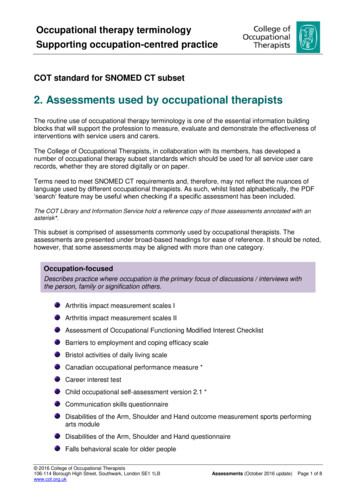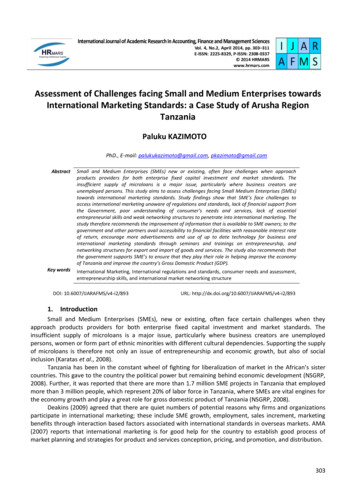
Transcription
International Journal of Academic Research in Accounting, Finance and Management SciencesVol. 4, No.2, April 2014, pp. 303–311E-ISSN: 2225-8329, P-ISSN: 2308-0337 2014 HRMARSwww.hrmars.comAssessment of Challenges facing Small and Medium Enterprises towardsInternational Marketing Standards: a Case Study of Arusha RegionTanzaniaPaluku KAZIMOTOPhD., E-mail: palukukazimoto@gmail.com, pkazimoto@gmail.comAbstractSmall and Medium Enterprises (SMEs) new or existing, often face challenges when approachproducts providers for both enterprise fixed capital investment and market standards. Theinsufficient supply of microloans is a major issue, particularly where business creators areunemployed persons. This study aims to assess challenges facing Small Medium Enterprises (SMEs)towards international marketing standards. Study findings show that SME’s face challenges toaccess international marketing unaware of regulations and standards, lack of financial support fromthe Government, poor understanding of consumer’s needs and services, lack of essentialentrepreneurial skills and weak networking structures to penetrate into international marketing. Thestudy therefore recommends the improvement of information that is available to SME owners; to thegovernment and other partners avail accessibility to financial facilities with reasonable interest rateof return, encourage more advertisements and use of up to date technology for business andinternational marketing standards through seminars and trainings on entrepreneurship, andnetworking structures for export and import of goods and services. The study also recommends thatthe government supports SME’s to ensure that they play their role in helping improve the economyof Tanzania and improve the country’s Gross Domestic Product (GDP).Key wordsInternational Marketing, International regulations and standards, consumer needs and assessment,entrepreneurship skills, and international market networking structureDOI: 10.6007/IJARAFMS/v4-i2/8931.URL: uctionSmall and Medium Enterprises (SMEs), new or existing, often face certain challenges when theyapproach products providers for both enterprise fixed capital investment and market standards. Theinsufficient supply of microloans is a major issue, particularly where business creators are unemployedpersons, women or form part of ethnic minorities with different cultural dependencies. Supporting the supplyof microloans is therefore not only an issue of entrepreneurship and economic growth, but also of socialinclusion (Karatas et al., 2008).Tanzania has been in the constant wheel of fighting for liberalization of market in the African’s sistercountries. This gave to the country the political power but remaining behind economic development (NSGRP,2008). Further, it was reported that there are more than 1.7 million SME projects in Tanzania that employedmore than 3 million people, which represent 20% of labor force in Tanzania, where SMEs are vital engines forthe economy growth and play a great role for gross domestic product of Tanzania (NSGRP, 2008).Deakins (2009) agreed that there are quiet numbers of potential reasons why firms and organizationsparticipate in international marketing; these include SME growth, employment, sales increment, marketingbenefits through interaction based factors associated with international standards in overseas markets. AMA(2007) reports that international marketing is for good help for the country to establish good process ofmarket planning and strategies for product and services conception, pricing, and promotion, and distribution.303
International Journal of Academic Research in Accounting, Finance and Management SciencesVol. 4 (2), pp. 303–311, 2014 HRMARSMarket provides evidence that markets entry costs for start-up firms are significant across countries(Djankov et al., 2002). SME policy of Tanzania (2002) indicates that Tanzania has been in the constant move tobuild and support SMEs for job creation and income generation activities.Despite the ongoing reform programs for economy in Tanzania, SMEs face challenges for internationalmarketing standards. Arusha being the heart of the economic development of Tanzania because of its level oftourist’s sites and also the capital city for the East Africa Community, this study aimed to assess the challengesfacing SMEs in Arusha towards international marketing standards.1.1. Objectives of the studyThis study aims to assess challenges facing Small Medium Enterprises (SMEs) towards internationalmarketing standards in Arusha.1.2. Research QuestionsWhat are the challenges facing SMEs towards international marking in Arusha?2. Literature review2.1. Non-Access to International MarketingInternational marketing is a multinational process of planning and executing international marketingstandards for pricing, promotion, distribution of ideas, goods and services to create exchange that satisfyindividual and organizational on national and international level (Kottler, 2009). Firms expand intointernational markets slowly and deliberately over time for the market that are familiar to their home market(Johanson et al., 1977).International market has generally been assumed to take place when the production process becomesmore standardized to take advance of certain factors unique to specific locations. Kottler (2012) and King andMcGrath (2002) show that there are strategies that entrepreneurs can apply to penetrate the internationalmarket such as exportation, joint venture, and direct investment for international production.Education program is one of the most important factors that positively have impact on the growth ofSMEs. A considerable growth of SMEs in international markets characterizes an international involvement.The global market provides new business opportunities such as innovation and new export markets withactivities for large firms and between SMEs themselves. SMEs have played a central role in developing theprivate sector and integrating into the global economy as an efficient way to alleviate poverty in developingcountries (Raynard and Forstater, 2002).Abonyi (2003) recommended that to participate effectively in global markets, SMEs are required tohave and maintain significant capabilities in different areas ranging over the industry value chain, includingproduction, design, distribution, branding, and marketing. Amyx (2005) finds that the most significantchallenges facing SMEs is the negative perception that their clients have on their ability to provide adequateand quality services for their needs.Longenecker et al. (2005) and Oketh (2000) find that improper planning and poor management havebeen posited as main causes of failure for SMEs. Lack of credit has been identified as one of challenges facingSMEs and that hinders their growth towards international marketing. And with the current trends ofglobalization, SMEs are facing a turbulent environment in which competition is intensifying whilst their sizeand other existing constraints remain the same.2.2. Lack of International Marketing Standards and regulationsFariza (2012) suggested that Governments should continuously upgrading the environment so that it isconducive to the international growth and development of SMEs, by proactively seeking internationalbusiness opportunities, strengthening legal institutions and administrative and financial establishments, andformulating appropriate policies.Marketing and information are two of export problems, which revolve around lack of knowledge offoreign markets business practices and competition strategies, lack of strategies for sales management, lack304
International Journal of Academic Research in Accounting, Finance and Management SciencesVol. 4 (2), pp. 303–311, 2014 HRMARSof are percents to be major barrier in exporting of SMEs in developing countries (Siringoringo et al., 2009). Li(2004) provides evidence that international marketing knowledge is depending on the relevance and depth ofmarketing information available to the firm. Karatas et al. (2008) find insufficient supply of microloans is amajor issue, particularly where business creators are unemployed persons, women or form part of ethnicminorities. Supporting the supply of microloans is therefore not only an issue of entrepreneurship andeconomic growth, but also of social inclusion.The point is that (http://www.oecd.org) SMEs face internal and external challenges. Internal barriersinclude limited information to locate and analyse markets, inefficiencies of human resource management withregard to internationalisation, lack or insufficiency of finance with regard to internationalisation, pressuresimposed by external forces on adapting the elements of the company’s product and pricing strategy, barriersassociated with the distribution, logistics and promotion aspects of in foreign markets. External barriersinclude: aspects of transactions with foreign customers, actions or inaction by the home and foreigngovernment in relation to its indigenous companies and exporters, firm’s customers and competitors inforeign markets, the economic, political-legal and socio-cultural environment of the foreign market(s),restrictions on exporting and internationalising imposed by government policies and regulations in foreignmarkets.Stroyan et al. (2012) ascertains that international marketing standards play a number of important rolesin the economy, support innovation, growth and competitiveness of countries. Standards also offer manysignificant benefits for individual businesses and industries, and provide SMEs with a vital competitive edge.Further, they stated that SMEs could play a fuller role in standardization, but are unhampered by a number offactors that include: lack of awareness of standards relevant to their business, perception that they are morerelevant to large business, and lack of hum (technician) and financial resources to both develop and make useof standards.Studies have pointed out that a range of barriers faced by SMEs concerned with their awareness ofinternational marketing regulations and standards (either generally, or of relevant to their business), any or allof which may prevent them from realizing the full benefits that standards can bring. Insufficient awarenessmay originate lacking relevant knowledge, or a failure to communicate effectively, and no involvement ofSMEs in income growth, entrepreneurial training, and creation of technological capabilities (Katrak andStrange, 2002; Weeks, 2002). Hamisi (2011) indicates that SMEs have the necessary wherewith to improve itssituation, not only in terms of their resources, but also in terms of supply chain strategy for internationalregulations and standards.2.3. Lack of Government Support to SMEsDespite existing policies on financial support for small businesses, very few entrepreneurs receivefinancial help when they need it. Mambula (2002) find that 72 percent of entrepreneurs he studied in Nigeriaconsidered lack of financial support as number one constraint in developing their business. Although in someAfrican countries banks are by law required to set aside a certain percentage of their profits for small businessloans, many banks would rather pay a fine than make what they believe to be a high risk loan to SMEs.Akwani (2007) suggests that basic physical infrastructure required for economic development, such asgood roads, ample power supply, and good rail and river transportation facilities, are in very poor shape inmost African countries. In addition to the problems noted above, the information and communicationinfrastructure in most African countries are weak. Cogburn and Adeya (2000) find that access to informationinfrastructure is considered as an indispensable condition for widespread socio-economic development in thisage of globalization and information economy SMEs and other small African firms have challenges to joininternational market and sell their products in their home market.Small business assistance from governments of African countries is weak and inadequate. Mostresearch studies on African entrepreneurship have concluded that training programs for entrepreneurs havebeen few and far between and different in content than what is needed (Wallace, 1999). The technologyinvolved in the training tended to be beyond what trainees can afford to buy and use. In most cases there wasno after-training follow up services.Access to bank loans and direct government financial support are reported in surveys of entrepreneursas a serious problem for small businesses in Africa (Honohan and Beck, 2007). Better financial assistance is305
International Journal of Academic Research in Accounting, Finance and Management SciencesVol. 4 (2), pp. 303–311, 2014 HRMARSneeded to address this problem. According to Honohan and Beck, African firms finance a significantpercentage of their investment with internal funds, about 68 percent. This observation highlights lack offinancial assistance to small-scale enterprises. Policies to address this problem should be established withinput from lending institutions.Honohan and Beck (2007) suggest that the concerns of banks should be taken into consideration indeveloping financial support policies for small businesses. Governments should work with lending institutionsto lower the risk of loan default. While governments need to play an important role, other sources ofassistance to small businesses, such as venture capitalists, should be considered. It is also important thatentrepreneurs recognize the benefits of education and training in ensuring the success of any businessendeavor.Despite all the challenges facing entrepreneurship in Africa, economic growth rates across much ofAfrica are rising, and there are successful entrepreneurial ventures across the continent (BBC News, 2006).This observation suggests that opportunities exist for African entrepreneurs, and some of these opportunitieshave already resulted in some international and local business successes.2.4. Setting customer services and needs satisfactionLarge buyers are important drivers of technological innovation in global value chains because of theiremphasis on higher product standards, constant threat of supplier replacement, and support of theircustomers and suppliers (Kula et al., 2006). Individuals or organizations may get involved in InternationalMarketing in a rather unplanned way that gives the impetus to more formal and larger operations. The smallscale enterprises enquiries through word of mouth, visits, exhibitions, and experience through others mayresult in orders. These may be of domestic based export merchants, domestic based export agents, exportmanagement companies or cooperative organizations (Agriculture and Consumer Protection, 1997).Zeithaml et al. (2008) find that SMEs struggle to ensure that the right product is available in the rightquantities at operational level. Some SMEs have targeted specific customer service level, but have beenunable to translate their growth plans into improved category performance, largely due to operationalinefficiencies. Others suffered as a result of consumer feedback, an indication that the SME outlets seemed tohave frequent out-of-stocks, affecting consumer brand image for the SME and increasing lost sales. AndGrönroos (2000), and Zeithaml et al. (2008) agree that it is important to make each and every serviceencounter a positive experience for the customer, focusing on creation and building social bonds withcustomers. According to Customer satisfaction is when the outcome of the service matches the expectations.Kotler et al. (2005) show that customer satisfaction consists of other factors inherent in the service andoutside of the service: The service as a product itself, and the other human interactions or influencesinvolved, respectively.Dealing with competitiveness in the field of SMEs development means to strengthen the ability andperformance of SMEs to satisfy customer demands/requirements better than competitors. This can be doneby selling and/or supply goods and/or services success- fully; to meet the quality standards of target marketsat prices that are competitive; and provide adequate returns on the resources employed in producing them(TNA REPORT, 2010).2.5. Lack of Skills for entrepreneurshipThe challenges facing entrepreneurs and small medium enterprises in Africa are varied and many; lackof financial support, weak economic infrastructure, and lack of policy coherence, and lack business support.Given the small number of indigenous African small firms compared to firms from other parts of the world,education and training support for entrepreneurs and small-scale enterprises will help establish a goodfoundation for small business growth (Biggs and Shah, 2006).TNA Report (2010) indicates that sales and marketing are regarded as the most important knowledgeareas to develop, followed by innovation & technology, leadership, production management, qualitymanagement systems, export promotion, tax/laws, finance and control, personnel and organization andproblem-solving skills. Further, the report states that the process of gaining and consolidating competitiveadvantage requires a variety of skills and knowledge relating to the changing features of company business. Inpractice this means that SME training and other business support services should play an important leverage306
International Journal of Academic Research in Accounting, Finance and Management SciencesVol. 4 (2), pp. 303–311, 2014 HRMARSeffect and enhance competitive advantage through their supporting and facilitating efforts in the learningprocess of the entrepreneur.2.6. Weak Networking Structure for international marketingThe reasons given for the unfavorable internationalization of small firms in Africa includes: unsaturateddomestic markets, reputation for small quantity although quality products, low technological requirement forsuccess in markets, and difficulties in joining international supply-chain networks (Rankin et.al, 2006). Interfirm linkages between small and large firms or domestic and international enterprises in value chainscontribute to small firms' growth and success. This type of cooperation allows small firms to reap the benefitsof scale and scope economies. The skills small firms develop and knowledge they acquire in inter-firm linkagecan lead to competitive advantage in the global marketplace (McCormic, 1999).Lawrence (2005) indicates that linkages between small firms and large firms are generally weak at thistime, especially between small manufacturing firms and agricultural suppliers. In addition to that large foreigncompanies are reluctant to establish local linkages with small enterprises because of product quality concerns(Yumkella and Vinanchiarachi, 2003). This weak linkage between large and small medium enterprises is aproblem for future small business development. Building inter-firm linkages in African countries will requiregovernment policies that create an enabling investment environment through tax incentives, red tapereduction, property protection, and other measures that have a positive impact on the overall economy (UNConference on Trade and Development, 2007).3. Methodology of researchParticipantsThe study used the descriptive design with descriptive techniques. 50 respondents were accessed forprimary data. The secondary data set includes views and arguments from deferent scholars and otherrelevant studies. The demographic data of the survey show that more than half 62% of respondents werewomen and only 38% of respondents were man. Based on education, more than half 56% have achievedsecondary level of education, 28% of respondents have passed only primary level of education, 10% havedegree from university, and only 6% of them have Postgraduate level of studies. The results further indicatethat 52% of the respondents own the business, 30% of respondents are employed, and only 18 % of them areworking from family organization.MeasuresA structured questionnaire was administered to the participants of the study. The tool was designed toassess challenges facing SMEs towards international marketing. The tool had 2 parts: a) identification andprofile of respondents, b) assessment of challenges facing SMEs towards international marketing.For respondent’s profile questions are asked in real mean of their gender, age, education, experience,housing status, and capital for their business. On the other hand challenges are assessed using a 3-point scale:Disagree, Moderate, and Agree.ProcedureData set from this study is collected from respondents that practices and are SMEs entrepreneurs. Thestudy used different respondents given the anonymous nature of participation. Respondents were explainedof the purpose of the study and were encouraged to give truthful answers. Responses of respondents wereelectronically coded and saved for analysis using Statistical Package for Social Sciences (SPSS) 16.Data AnalysisThe data sets were analyzed using descriptive techniques. To assess the challenges of SMEs facing forinternational market frequencies, mean, variance and percentages for arguments and opinions werecomputed. For simplicity, percentages of corresponding responses for each variable were discussed. Since it isnot the interest of the study to examine the relationship between variables any inferential statistics were not307
International Journal of Academic Research in Accounting, Finance and Management SciencesVol. 4 (2), pp. 303–311, 2014 HRMARSreported. The consistency of the descriptive techniques as stated above was analyzed at face value byobserving the highest and lowest.4.ResultsTable 1. Challenges of SMEs towards international marketingVariablesNon-Access to international ree4559010Lack of International marketing regulations and standardsLack Government supportLack of consumer services and Needs assessmentsLack of skills for entrepreneurshipWeak networking structures for SMEsAccess to International MarketingResult shows that 72% (36) of respondents agreed that they don’t have access to the internationalMarketing, and only 28% (14) disagreed. Despite the opportunities that regions are making possible forentrepreneurs, SMEs in Arusha still have difficulty do not have access to international market. This means thatSMEs are unable to penetrate the international market. The majority is relying on local market for theireconomic development. This confirms the findings of Johanson et al. study (1977) reporting that firms expandinto international markets slowly and deliberately over time for the market that are familiar to their homemarket.The result opposes with the study of Kottler (2012), Abonyi (2003) and King and McGrath (2002) statingthat there are strategies that entrepreneurs can apply to penetrate the international market, and toparticipate effectively in global markets, SMEs are required to have significant capabilities in different areasranging over the industry value, including quantity and quality of production, distribution, and marketing. Alsoit is observed that SEMs in Arusha have improper planning and poor management that have been posited asmain causes of failure to have access to the international marketing (Longenecker et al., 2005 and Oketh,2000).Lack of International marketing regulations and standards AwarenessThose who agreed on the factors that they are not informed on international marketing regulations andstandards for marketing in Arusha were 88% (44), and only 12% (6) disagreed. The study done by Fariza (2012)supports the findings that Governments should continuously upgrade the environment to the internationalgrowth and development of SMEs. The result is supported by Siringoringo et al., (2009) and Li (2004) showingthat marketing and information are the two fundamental problems, which revolve around lack of knowledgeof international marketing and foreign business practices. OECD report online supports the above result308
International Journal of Academic Research in Accounting, Finance and Management SciencesVol. 4 (2), pp. 303–311, 2014 HRMARSshowing that SMEs face internal that include limited information to locate and analyse markets, inefficienciesof human resource management with regard to internationalisation, lack or insufficiency of finance withregard to internationalisation.Stroyan et al. (2012) also confirms the result indicating that SMEs are facing number of challenges thatinclude: lack of awareness of standards relevant to their business, perception that they are more relevant tolarge business, and lack of technician to make use of the international marketing regulations and standards.Studies have pointed out that a range of barriers faced by SMEs concerned with their awareness ofinternational marketing regulations and standards either generally, or of relevant to their business (Katrakand Strange, 2002; Weeks, 2002).Lack of Government Support to SMEsThe question asked to assess the support of the government to SMEs businesses, 94% (47) ofrespondents agreed that there is support from the government to promote their businesses, and only 6% (3)agreed to have support from the government.The result is supported by the findings of Mambula (2002) study stating that despite existing policies onfinancial support for small businesses; very few entrepreneurs receive financial help when they need it. AndWallace (1999) confirms that small business assistance from governments of African countries is weak andinadequate. Honohan and Beck, (2007) agreed that African firms finance their investment with internal funds.Lack of Consumer Needs AssessmentsFindings indicate that 82% of respondents agreed to lack consumer needs assessments and strategiesfor competition, and only 18% disagreed. Large buyers are important drivers of technological innovation inglobal value chains because of their emphasis on higher product standards, and support of their customersand suppliers (Kula, Downing, and Field, 2006). This result confirms what the Agriculture and ConsumerProtection report (1997) find that small-scale enterprises consider word of mouth, domestic based exportmerchants, domestic based export agents, export management companies and cooperative organizations.Zeithaml et al. (2008) find that SMEs struggle to ensure that the right product is available in the rightquantities at operational level regardless customer services. Grönroos (2000), and Zeithaml et al. (2008) agreethat it is important to make each and every service encounter a positive experience for the customer, focusingon creation and building social bonds with customers.Skills for entrepreneurship and Relying on Local productsResult shows that 68% (34) of respondents agreed to have been doing business without enoughknowledge of entrepreneurship and they only rely on their local product, only 32 % (16) disagreed and statedto have knowledge of entrepreneurship and although relying on their local products. The challenges facingentrepreneurs and small medium enterprises in Africa are varied and many; lack of financial support, weakeconomic infrastructure, and lack of education and training support for entrepreneurs and small-scaleenterprises that would help establish a good foundation for small business growth (Biggs and Shah, 2006). Inpractice this means that SME training and other business support services should play an important leverageeffect and enhance competitive advantage through their supporting and facilitating efforts in the learningprocess of the entrepreneur (TNA Report, 2010).Weak networking structures for the international marketingFindings show that 90% (45) agreed to have weak relationship/network structures or not at all interactwith others partners in the global market, and only 10% (5) disagreed. The reasons given for the unfavorableinternationalization of small firms in Africa includes: unsaturated domestic markets, reputation for smallquantity although quality products, low technological requirement for success in markets, and difficulties injoining international supply-chain networks (Rankin et al., 2006). Inter-firm linkages between small and largefirms or domestic and international enterprises in value chains contribute to small firms' growth and success.This type of cooperation allows small firms to reap the benefits of scale and scope economies. The skills small309
International Journal of Academic Research in Accounting, Finance and Management SciencesVol. 4 (2), pp. 303–311, 2014 HRMARSfirms develop and knowledge they acquire in inter-firm linkage can lead to competitive advantage in theglobal marketplace (McCormic, 1999). Lawrence (2005) indicates that linkages between small firms and largefirms are generally weak at this time, especially between small manufacturing firms and agricultural suppliers.In addition large foreign companies are reluctant to establish local linkages with small enterprises because ofproduct quality concerns (Yumkella and Vinanchiarachi, 2003). This weak linkage between large and smallmedium enterprises is a problem for future small business development (UN Conference on Trade andDevelopment, 2007).5. ConclusionStudy findings show that SME’s lack financial power to produce quantity of their product to serve largecommunity. Further findings show that SMEs face challenges to access international marketing unaware ofregulations and standards, with poor understanding of consumer’s needs and services, lack of essentialentrepreneurial skills and weak networking structures to penetrate into international marketing. Further, theylack support and provision of loans leading to poor growth of the SMEs economy development in ArushaRegion. The study therefore recommends the improveme
insufficient supply of microloans is a major issue, particularly where business creators are unemployed persons. This study aims to assess challenges facing Small Medium Enterprises (SMEs) towa
